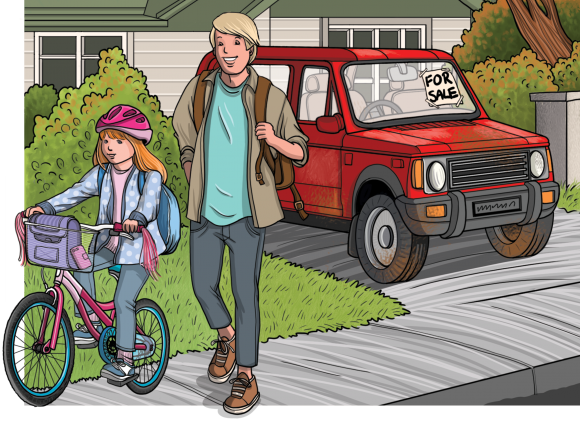On The Move

| Travel Actions | Ideas useful as climate adaptation | Ideas useful as emission mitigation. |
|---|---|---|
Plan travel to reduce the distance you drive each week, especially if you are a solo driver on a long daily commute. Actions to consider in some jobs could be a day a week working at home or regular sharing of work commute and/or school children’s transport. Also plan combined work and shopping visits. Read more: https://genless.govt.nz/for-everyone/on-the-move/explore-transport-options/ | Sharing your car reduces the number of emitting vehicles on the road, helps reduce demand for road and parking space, and tyre wear on bitumen-sealed surfaces. As daily car use falls, there could be public space released for shade-providing roadside trees and rain-permeable gardens. | Transport is the top contributor to a household’s carbon emissions. There is an opportunity to significantly reduce your emissions by driving less. For example, avoiding car commuting just one day a week (by working at home or being a passenger in another’s car) on a 80km daily round trip would save 700kg CO2e per year. |
For shorter work commuting journeys under 10km, consider alternatives. Use buses where available, cycle, scooter, walk or jog. Could your household reduce the number of cars you own? Town residents might go car-free, and if licensed drivers, hire a vehicle for occasional use instead of owning one? | Compared to cars, cycles reduce road surface wear, lane and parking space demand, so we could eventually need fewer of the sealed surfaces which don’t soak up rainwater and tend to contribute to local flooding in heavy rain. | Significant carbon emission reductions from sharing compared to driving these journeys solo. If you switched from car to cycle or e-scooter on a 10km each-way daily commute, you’d save 875kg CO2e in a year. Battery assisted E-bike, bus travel or car sharing alternatives would still create some emissions, yet you’d still save hundreds of kg annually. Weblink on E-bikes: https://www.consumer.org.nz/products/electric-bikes/guide |
Reduce average speed of travel in your current vehicle and/or use a hybrid engine car. Lower urban traffic speeds create safer road conditions for alternative travel modes such as cycling and walking. Read how slower speeds save lives: https://www.nzta.govt.nz/safety/driving-safely/speed/ | Slower traffic in towns allows use of narrower roads, so space could be released for walkers, and street trees, which absorb CO2 and provide summer shade. | Some carbon emission reduction, as fuel is used more efficiently if you accelerate gently and brake less often. In a hybrid car, braking puts energy back into the battery which is then available to use in acceleration in slower urban traffic, replacing fuel. You might save 300 kg CO2e in a year. |
Take fewer air flights, especially internationally. Holiday nearer home. Use video conferencing to replace ‘in person’ for meetings and keeping more distant family connections. | Flying less reduces water vapour, N2O and CO2 emission into the upper atmosphere, where it is most damaging. Stormier weather generated by a warmer climate may make departures less reliable and turbulent, so flying may become less comfortable and convenient. | 12% of New Zealand’s carbon emissions by 2020 are Frequent flyers paying extra to ‘offset’ the carbon |
| Travel Investment | Useful as climate adaptation | As emission mitigation |
Switch to a fuel-efficient vehicle. Such as a plug-in hybrid or a Battery Electric Vehicle, which is charged cheaply at home overnight and can use more expensive public fast chargers in towns and along main highways. Read more: https://genless.govt.nz/for-everyone/on-the-move/consider-electric-vehicles/charging-an-ev/public-charging-your-ev/ Online map from Plugshare shows a range of charger providers, (including Charge Net, BP fuel, Z fuel and Meridian Zero): https://www.plugshare.com/ | Roadside air quality improvements from reduced fumes, and reduction of the urban overheating (‘heat island’) effect in summer. Read more: https://environment.govt.nz/what-you-can-do/stories/reducing-he-impact-of-urban-heat-islands/ | Significant carbon emission reductions using battery electric vehicle compared to fuel burning in internal combustion engine. NZ electricity is not entirely renewable (especially at peak load times), so it’s best to recharge a battery electric or plug-in hybrid vehicle at home after 9pm & before 7am, which may qualify for discount on some power retailer accounts. About two tonnes more carbon is emitted in the manu- facture of a battery EV than a conventionally fuelled car, although they make up for this in a few years of use through avoided burning of petrol or diesel, after which they’re a positive improvement. |
Last updated: 04 Jun 2024